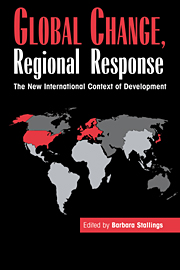Book contents
- Frontmatter
- Contents
- List of tables and figures
- List of contributors
- Acknowledgments
- Abbreviations
- 1 Introduction: global change, regional response
- Part I Global changes
- Part II Regional responses
- 7 The East Asian NICs: a state-led path to the developed world
- 8 Southeast Asia: success through international openness
- 9 Latin America: toward a new reliance on the market
- 10 Sub-Saharan Africa: underdevelopment's last stand
- Part III Conclusions
- Index
8 - Southeast Asia: success through international openness
Published online by Cambridge University Press: 05 June 2012
- Frontmatter
- Contents
- List of tables and figures
- List of contributors
- Acknowledgments
- Abbreviations
- 1 Introduction: global change, regional response
- Part I Global changes
- Part II Regional responses
- 7 The East Asian NICs: a state-led path to the developed world
- 8 Southeast Asia: success through international openness
- 9 Latin America: toward a new reliance on the market
- 10 Sub-Saharan Africa: underdevelopment's last stand
- Part III Conclusions
- Index
Summary
After nearly three decades of steady economic growth, the six capitalist countries of Southeast Asia today constitute the world's fastest-growing regional economy. The six (Indonesia, Malaysia, the Philippines, Singapore, Thailand, and Brunei) form the Association of Southeast Asian Nations, known as ASEAN. In contrast to their relatively homogeneous Northeast Asian neighbors, the ASEAN countries are characterized by extreme ethnic, cultural, and religious diversity. Their European colonial heritage is equally diverse. Yet unlike other ethnically diverse, European-colonized developing regions such as Africa, the Middle East, and South Asia, the ASEAN countries have maintained ethnic harmony and political peace for decades. Their sustained economic success challenges popular ideologies that, for example, Confucianism is conducive to capitalist economic development while Islam is not, or that colonialism is the primary cause of economic development failure in postcolonial societies. In contrast to ASEAN's success, the four socialist countries of Southeast Asia – Vietnam, Cambodia, Laos, and Burma (Myanmar) – have been counted among the world's poorest and least successful economies, with their 120 million citizens suffering decades of war and civil strife. Tables 8.1 and 8.2 document the economic contrasts between these two groups of countries.
The ASEAN countries' economic success is particularly distinctive for its heavy dependence on the world economy, continuing the region's more than 1,000-year history of widespread participation in maritime-based trade. This is the result of Southeast Asia's distinctive geography, which consists of peninsular and archipelagic territories lying astride the major world sea-trading route between the great empires of China to the north and India to the west.
- Type
- Chapter
- Information
- Global Change, Regional ResponseThe New International Context of Development, pp. 238 - 271Publisher: Cambridge University PressPrint publication year: 1995
- 8
- Cited by



